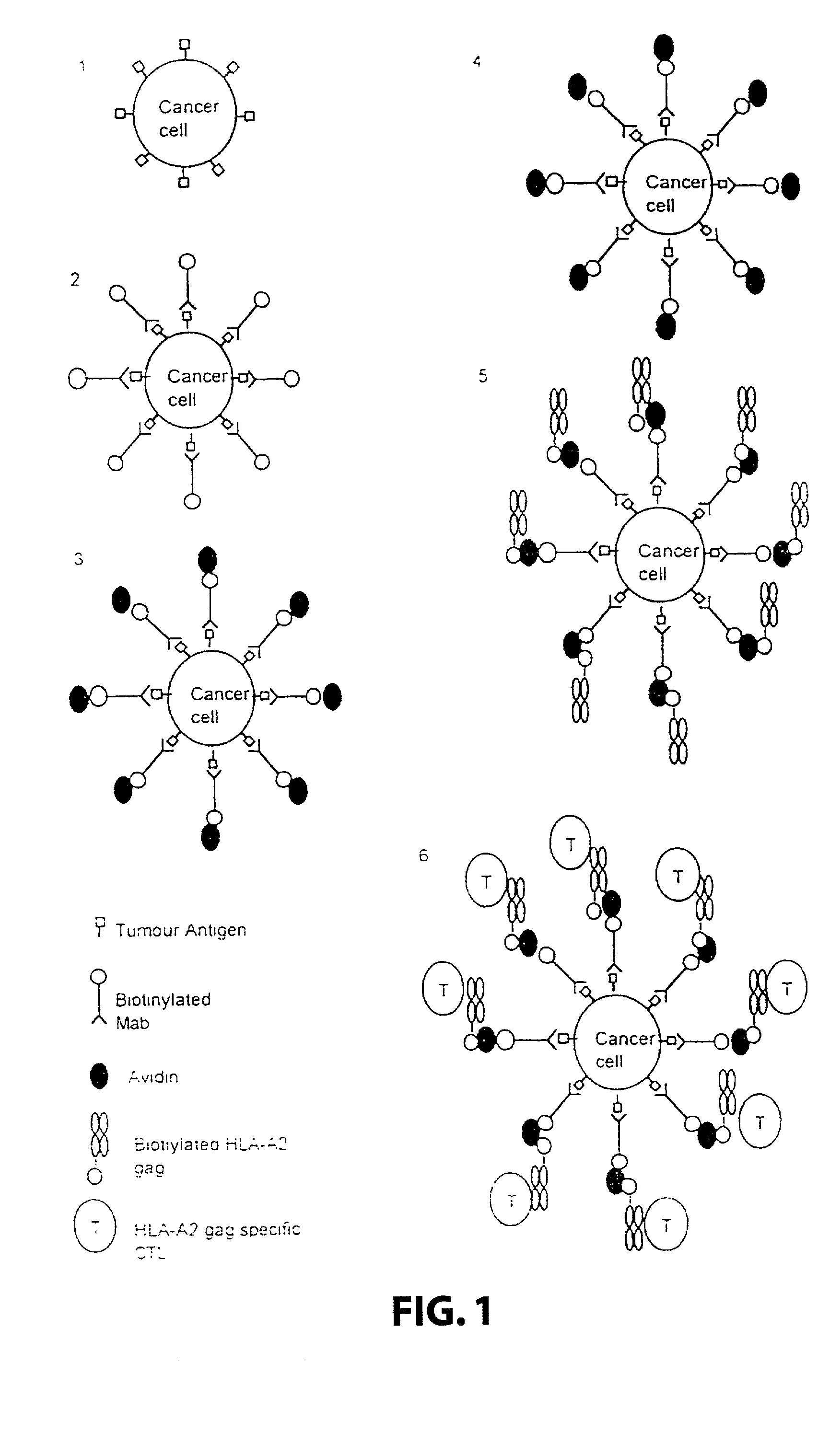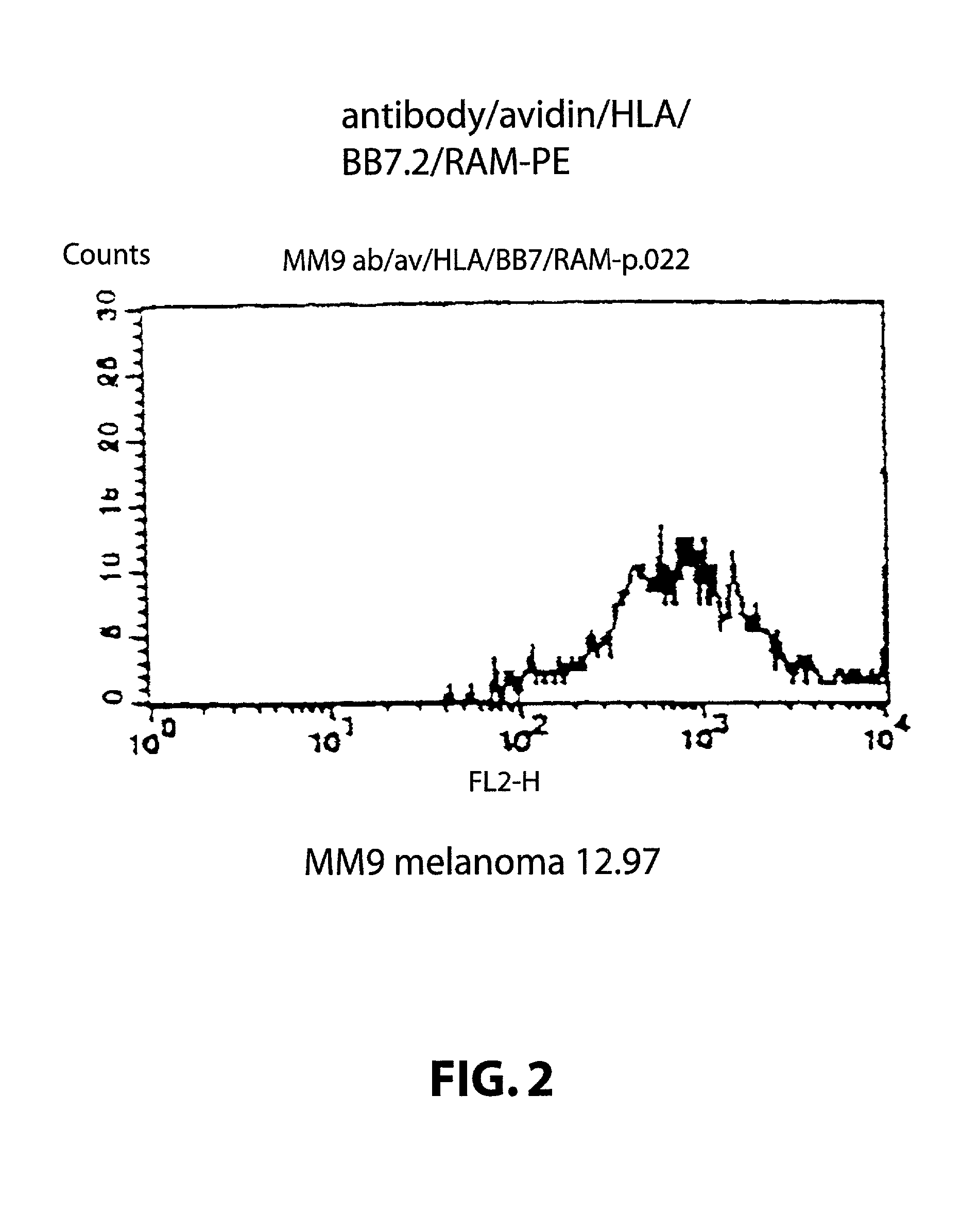Method for producing or enhancing a T-cell response against a target cell using a complex comprising an HLA class I molecule and an attaching means
a technology of t-cell response and complex, which is applied in the direction of peptide sources, anti-tumour cell ingredients, pharmaceutical non-active ingredients, etc., can solve the problems of difficulty in targeting tumour cells at multiple sites, and the number of hla molecules presenting such peptides is generally too small to stimulate an effective immunological respons
- Summary
- Abstract
- Description
- Claims
- Application Information
AI Technical Summary
Problems solved by technology
Method used
Image
Examples
example 1
[0123] The following components were used:
[0124] Target cells: A human melanoma cell line Mel 1, deposited at the Department of Immunology, Institute of Molecular Medicine, Oxford, that carries the HLA class I allotype HLA-A2. The cell line was grown in standard RPMI tissue culture media. A human melanoma cell line Mel 2, deposited at the Department of Immunology, Institute of Molecular Medicine, Oxford, that does not carry the HLA class I allotype HLA-A2. The cell line was grown in standard RPM1 tissue culture media.
[0125] Attaching means: A monoclonal antibody 225.28s (Buraggi 1985 Cancer Res. 45 3378-3387) that binds to the HMW-MAA antigen on human melanoma cells. Biotin is chemically conjugated onto this antibody as described in Bayer 1990, Methods Embryology 184, 138-160.
[0126] Pure hen egg avidin obtained commercially from Societa Prodotti Antibiotics, Milan, Italy.
[0127] HLA: Biotin conjugated recombinant HLA class I allotype HLA-A2 molecules, as described in Altman 1996, Sci...
example 2
[0136] The following components were used:
[0137] Target cells: The Daudi B cell line (MHC class I-negative) melanoma line SK-mel-29 (HLA-A2. 1-positive), 0.221 / A2 (HLA-A2.1-positive), were maintained in RPMI media with 10% fetal calf serum and antibiotics in a 37.degree. C. incubator with 5% CO2.
[0138] Attaching means: Monoclonal antibodies 225.28s (Buraggi 1985 Cancer Res. 45 3378-3387) and 2147 that bind to the I-IMW-MAA antigen. Biotin is chemically conjugated onto these antibodies as described in Bayer 1990, Methods Embryology 184, 138-160.
[0139] Pure hen egg avidin obtained commercially from Societa Prodotti Antibiotici, Milan, Italy.
[0140] HLA: Biotinylated complexes of recombinant MHC class I and peptide were produced as described previously (Altman et al, Science 274, 1996, 94-96; Ogg et al, Science 279, 1998, 2103). Prokaryotic expression of B2M and MHC class I heavy chain, modified by the C terminal addition of a target sequence for the biotin ligase enzyme BirA, was follo...
example 3
Figures for Example 3
[0155] FIG. 10. Shows 5 graphs. In more detail, FIG. 10 shows a FACs analysis of the time course of binding of HLA-A2 / M1 peptide complexes to HLA class I-ve cells (Daudi) via an antibody bridge. (Detected with an FITC conjugated anti-MHC monoclonal antibody (W6 / 32) (this antibody recognises HLA class I that is conformationally correct) (Ancell Ltd)
[0156] FIG. 11. Shows a bar chart, four scatterplots, a further barchart, four further scatterplots, and six further scatterplots. In more detail, FIG. 11 illustrates the result of a Tetramer FACs analysis of the cells cultured from peripheral blood cells incubated with or without the anti-CD20 B9E9-streptavidin fusion protein and HLA-A2 / M1 peptide complex. The cells are dual stained with a FITC conjugated monoclonal antibody to CD8 and a PE conjugated HLA-A2 tetramer with specificity for HLA-A2 / MI. FIG. 11 further shows the results of Tetramer FACs analysis of the cells cultured from PBLs incubated with either the ant...
PUM
| Property | Measurement | Unit |
|---|---|---|
| concentration | aaaaa | aaaaa |
| concentration | aaaaa | aaaaa |
| temperature | aaaaa | aaaaa |
Abstract
Description
Claims
Application Information
 Login to View More
Login to View More - R&D
- Intellectual Property
- Life Sciences
- Materials
- Tech Scout
- Unparalleled Data Quality
- Higher Quality Content
- 60% Fewer Hallucinations
Browse by: Latest US Patents, China's latest patents, Technical Efficacy Thesaurus, Application Domain, Technology Topic, Popular Technical Reports.
© 2025 PatSnap. All rights reserved.Legal|Privacy policy|Modern Slavery Act Transparency Statement|Sitemap|About US| Contact US: help@patsnap.com



